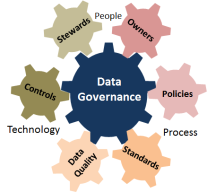Without Data Governance, The Best Intentions are Meaningless
Data Governance controls how information is defined, used, protected, and ultimately archived in your organization. Without Governance, information is just data; lacking context, standards, owners, or controls. Successful DG acknowledges that the business side of your organization owns information, not the IT side. There are many viable approaches to DG, but an organization must select the approach that best fits their business model, culture, and business goals.
Establishing a vision and fostering a Governance Organization is the cornerstone for any Enterprise Information Management initiative. Often, the vision involves fundamental cultural changes that requires experienced leadership to focus on the value and goals of a well-established Governance process. For the business, this involves definition and explicit ownership of all major business processes (i.e. product lifecycle, marketing, cash flow, order processing) and data domains (i.e. product, customer, reference data, employee, location). For a business-led DG initiative to succeed, there should be a partner IT governance initiative. IT initiatives include: Data Architecture standards, Data Quality processes, and Data Management standards.
Who to contact:




